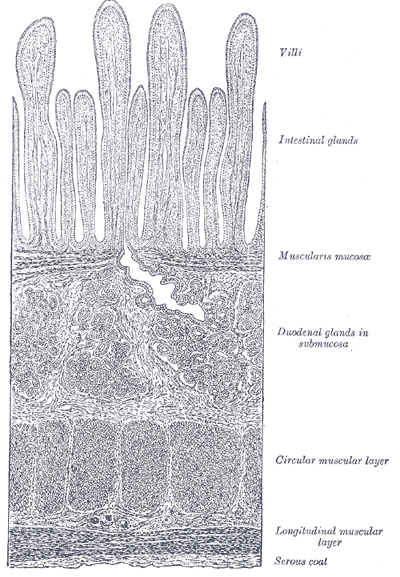22.13A: Absorption in the Small Intestine
- Page ID
- 8068
The absorption of nutrients occurs partially by diffusion through the wall of the small intestine.
- Describe the role played by the small intestine in the absorption of nutrients
Key Points
- Digested food is able to pass into the blood vessels in the wall of the small intestine through the process of diffusion.
- The inner wall, or mucosa, of the small intestine is covered in wrinkles or folds called plicae circulares that project microscopic finger-like pieces of tissue called villi, which in turn have finger-like projections known as microvilli.
- The function of the plicae circulares, the villi, and the microvilli is to increase the amount of surface area available for the absorption of nutrients.
- Each villus transports nutrients to a network of capillaries and fine lymphatic vessels called lacteals close to its surface.
Key Terms
- villi: Tiny, finger-like projections that protrude from the epithelial lining of the intestinal wall.
- plicae circulares: These circular folds (known as the valves of Kerckring or the valvulae conniventes) are large, valvular flaps that project into the lumen of the bowel.
- diffusion: The act of diffusing or dispersing something, or the property of being diffused or dispersed; dispersion.
EXAMPLES
Examples of nutrients absorbed by the small intestine include carbohydrates, lipids, proteins, iron, vitamins, and water.
The Small Intestine
The small intestine is the part of the gastrointestinal tract between the stomach and the large intestine where much of the digestion of food takes place. The primary function of the small intestine is the absorption of nutrients and minerals found in food.
Intestinal villus: An image of a simplified structure of the villus. The thin surface layer appear above the capillaries that are connected to a blood vessel. The lacteal is surrounded by the capillaries.
Digested nutrients pass into the blood vessels in the wall of the intestine through a process of diffusion. The inner wall, or mucosa, of the small intestine is lined with simple columnar epithelial tissue.
Structurally, the mucosa is covered in wrinkles or folds called plicae circulares—these are permanent features in the wall of the organ. They are distinct from the rugae, which are non-permanent features that allow for distention and contraction.
From the plicae circulares project microscopic finger-like pieces of tissue called villi (Latin for shaggy hair). The individual epithelial cells also have finger-like projections known as microvilli. The function of the plicae circulares, the villi, and the microvilli is to increase the amount of surface area available for the absorption of nutrients.
Each villus has a network of capillaries and fine lymphatic vessels called lacteals close to its surface. The epithelial cells of the villi transport nutrients from the lumen of the intestine into these capillaries ( amino acids and carbohydrates) and lacteals (lipids).
The absorbed substances are transported via the blood vessels to different organs of the body where they are used to build complex substances, such as the proteins required by our body. The food that remains undigested and unabsorbed passes into the large intestine.
Absorption of the majority of nutrients takes place in the jejunum, with the following notable exceptions:
- Iron is absorbed in the duodenum.
- Vitamin B12 and bile salts are absorbed in the terminal ileum.
- Water and lipids are absorbed by passive diffusion throughout the small intestine.
- Sodium bicarbonate is absorbed by active transport and glucose and amino acid co-transport.
- Fructose is absorbed by facilitated diffusion.

Section of duodenum: Section of duodenum with villi at the top layer.

